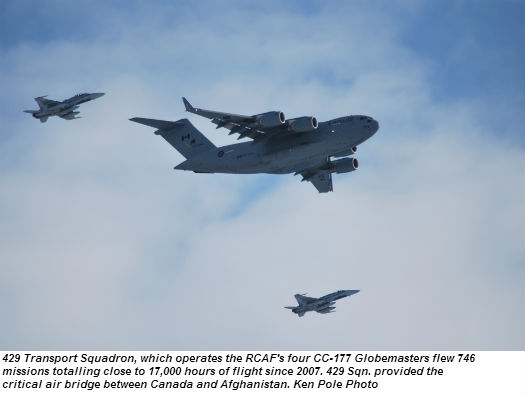Estimated reading time 3 minutes, 12 seconds.
The Royal Canadian Air Force put another historic mission into its logbooks on March 18 with the return of Canada’s last load of combat troopers from Afghanistan to Ottawa. Escorted by a pair of Boeing CF-18 Hornets from 425 Tactical Fighter Squadron of 3 Wing Bagotville, Que., the final detachment of 93 soldiers arrived aboard the CC-177 only a few days after lowering their final flag at Kabul.
Once on the ground in Ottawa, soldiers were greeted by friends, family, and a receiving line that included Prime Minister Stephen Harper, who said “all Canadians join with me to say ‘welcome home’ and ‘job well done.’” Capt. Dave Hicks from 429 ‘Bison’ Squadron then flew his Boeing CC-177 Globemaster III to its home at 8 Wing in Trenton, Ont.
Canada’s mission in Afghanistan began in late 2001 with the insertion of a small commando of special forces soldiers, and ensuing years saw the RCAF deliver 32,000 troops and 645 million pounds of freight to Kabul, Kandahar and Bagram airfields. The mission became the largest Canadian combat resupply effort since the Korean War.
Initially flying Lockheed Martin CC-130 Hercules tactical airlifters, 429 Squadron was the backbone of Canada’s supply operation. Its aircrews participated as part of Operation Apollo, a counter-terrorism mission, which began in October 2001 and ended two years later. In the first eight months of 2002 alone, Hercules crews logged more than 1,800 operational flying hours on more than 320 missions in the Arabian Gulf region. In that same period, 429 Squadron delivered 3,700 personnel and more than 4.5 million pounds of cargo in support of coalition forces.
The first RCAF tactical flight into Kandahar occurred in 2003 when 429 Squadron delivered 30,000 pounds of materiel to a bombed-out 3,900 foot long runway under direct small arms and rocket fire. With the introduction of its four CC-177 Globemaster IIIs in 2007, the squadron’s role expanded to a critical air bridge with regular sustainment flights, each usually with a crew of six and lasting seven to ten days.
Captain Hicks’ crew on the final trip home included Captain Adam Ackerson as First Officer; four loadmasters: Sergeants Wes Ramsay, Rich Less, and Chris Kingson and Master Corporal Tyler Ashbee; and four other personnel responsible for any technical and maintenance issues throughout the round trip: Master Corporals Jim Bateman and Mark Campion, and Corporals Nick Slauenwhite and Dalton Wardhaugh. Also aboard, but deadheading home, were Captains Tyler Simon and Adam Ackerson, respectively aircraft commander and first officer on other missions. The Hornet escorts returned to Bagotville as the Globemaster was touching down, their crews insisting on a low profile, saying only that they were happy to participate.

